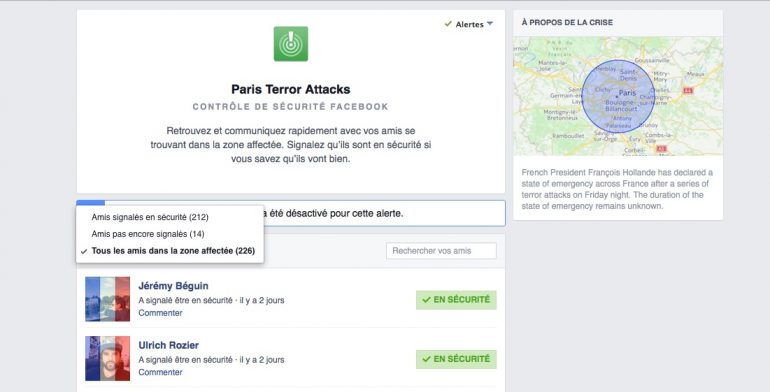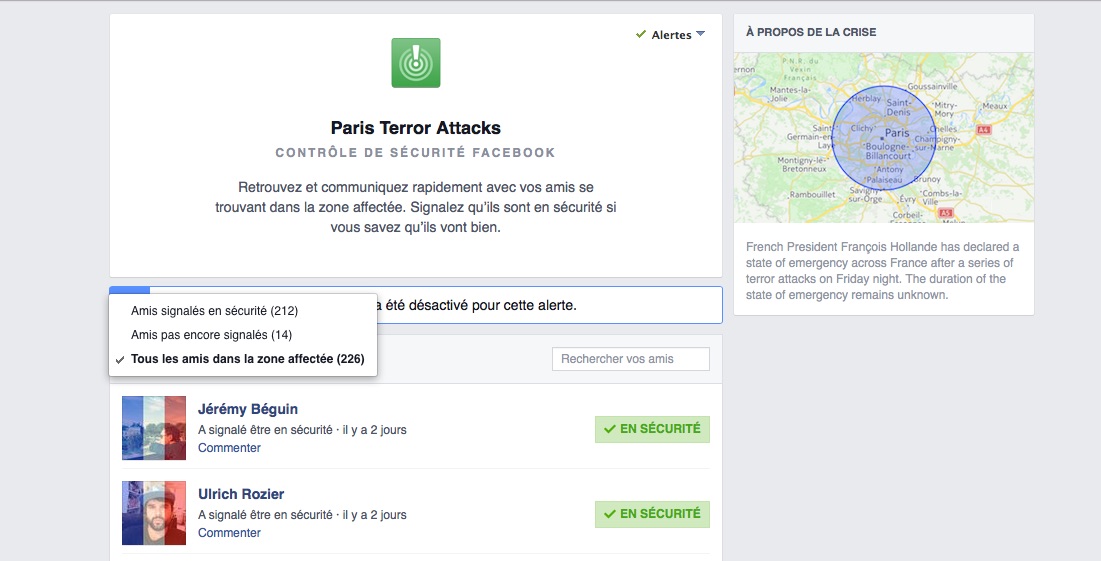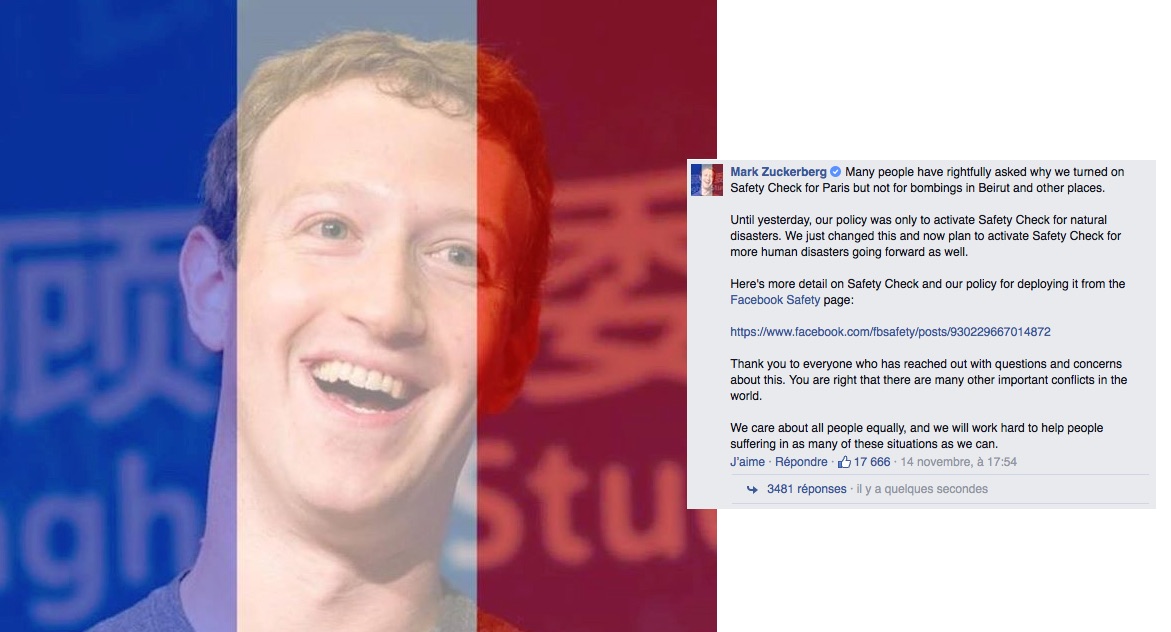En octobre 2014, Facebook annonçait le lancement de Saftey Check, une application qui permet aux personnes de signaler à leurs amis sur le réseau social s’ils sont en sécurité lorsque se produit une catastrophe. Alors que les attentats de Paris venaient d’avoir lieu vendredi dernier, le dispositif a ainsi été activé pour les personnes se trouvant dans une zone autour de la région parisienne.
Au total ce sont « plus 5,4 millions de personnes qui ont utilisé Facebook Saftey Check et plus 360 millions de personnes qui ont été notifiées que leurs amis étaient en lieu sûr ». S’il ne s’agit pas d’un outil totalement universel et fiable, certaines personnes en sécurité ne l’utilisant pas ou certaines personnes n’ayant pas cette possibilité alors qu’elles sont bien de Paris, il a quand même joué un rôle très important pour rassurer de nombreuses personnes.
Cependant, le Facebook Safety Check a été pointé du doigt, car si le dispositif a été activé pour les attentats de Paris, cela n’a pas été le cas pour l’attentat de Beyrouth la veille. Beaucoup d’incompréhensions de la part des personnes alors que celui-ci, également revendiqué par l’État Islamique, a provoqué la mort d’une quarantaine de personnes et que le Liban fait face au terrorisme, comme d’autres pays du Moyen-Orient et du Maghreb.
Des critiques qui sont entendues par Facebook puisque le Safety Check va connaître une évolution à la suite des attentats de Paris. Si à l’origine il était principalement prévu pour aider les populations à signaler leur situation en cas de catastrophe naturelle, le dispositif va maintenant s’étendre aux drames humains, comme les attaques terroristes notamment.
Marck Zuckerberg, dans un statut pour exprimer sa solidarité avec la France, a ainsi annoncé l’évolution du Facebook Check : « De nombreuses personnes ont demandé à raison pourquoi nous avons activé le Safety Check pour Paris mais pas pour les explosions à Beyrouth ou ailleurs. Jusqu’à vendredi, notre politique était d’activer le Safety Check pour les catastrophes naturelles. Nous venons juste de la faire évoluer et nous prévoyons désormais de l’activer pour les désastres humains qui surviendront à l’avenir ».
Alex Schultz, Vice President of Growth, donne d’ailleurs plus de détails sur la page dédiée au Facebook Safety Check. Il explique notamment l’origine du dispositif pour les catastrophes naturelles à la suite du Japon en 2011 et le choix d’activer celui-ci lors des attentats de Paris.
Yesterday, we activated Safety Check in Paris so that people there could let their friends and family know they were okay during the horrific events that took place. Communication is critical in moments of crisis, both for the people affected and for those far away who are anxious for news. People already turn to Facebook to check on loved ones and get updates during times like this and we created Safety Check to make these connections even easier.
Since we activated Safety Check in Paris, we have heard positive feedback about how reassuring it is to receive notifications that a friend or loved one is safe. I personally have received several from people I know and love and have felt first hand the impact of this tool. But people are also asking why we turned on Safety Check in Paris and not other parts of the world, where violence is more common and terrible things happen with distressing frequency. Thursday’s tragedy in Beirut is one recent example. I wanted to give some more background on the tool itself, its history and why we made the decision we did.
We were first inspired to create a very early version of Safety Check in Tokyo during the Tsunami and nuclear disaster in 2011. Facebook engineers on the ground were concerned, saw people posting they were safe and wanted to make that easier. A couple of passionate people at Facebook hacked together a solution that evolved into the Safety Check tool people are seeing today. We deployed this version of the tool for the first time in October of last year and have since activated it a handful of times; after the recent earthquakes in Afghanistan, Chile and Nepal as well as Tropical Cyclone Pam in the South Pacific and Typhoon Ruby in the Philippines. In the case of natural disasters, we apply a set of criteria that includes the scope, scale and impact. During an ongoing crisis, like war or epidemic, Safety Check in its current form is not that useful for people: because there isn’t a clear start or end point and, unfortunately, it’s impossible to know when someone is truly “safe.”
Each time we have launched the tool, we’ve improved it. We saw spam abuse with the tool in some launches, in others it has overwhelmed our notification systems because of the huge numbers of people wanting to tell their friends they are safe. We are learning to make the tool and policies behind it better as we go – and because Safety Check is a relatively new feature for us, we’re still understanding how it can best be used and in what instances.
We chose to activate Safety Check in Paris because we observed a lot of activity on Facebook as the events were unfolding. In the middle of a complex, uncertain situation affecting many people, Facebook became a place where people were sharing information and looking to understand the condition of their loved ones. We talked with our employees on the ground, who felt that there was still a need that we could fill. So we made the decision to try something we’ve never done before: activating Safety Check for something other than a natural disaster. There has to be a first time for trying something new, even in complex and sensitive times, and for us that was Paris.
This activation will change our policy around Safety Check and when we activate it for other serious and tragic incidents in the future. We want this tool to be available whenever and wherever it can help. We will learn a lot from feedback on this launch, and we’ll also continue to explore how we can help people show support for the things they care about through their Facebook profiles, which we did in the case for Paris, too.
We create products that we think will help people and we work hard to perfect the solution over time. Safety Check remains a work in progress, but one that has helped many people stay in touch with their friends and family during difficult times. We’re going to continue working to make it better and more useful.
–Alex Schultz, Vice President of Growth


